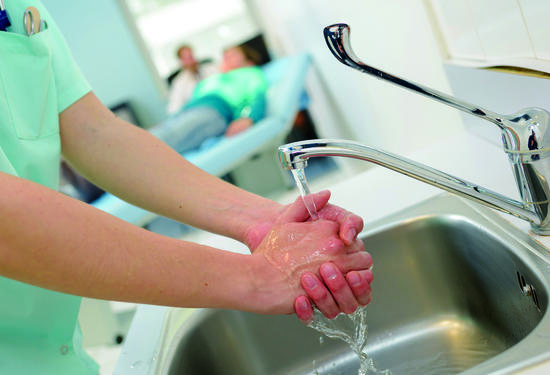Prepare Don’t Repair: Get Your Skin Care In Order This Winter
People who work with their hands on a daily basis rely on good skin condition. Damaged and broken skin does not just affect your workers’ skin health, it can have a detrimental impact on work productivity. As the winter months approach, so do colder temperatures and windier days; for those who work outdoors especially, this can have a significant impact on the health of the skin. In 2021 alone there were an estimated 8000 new cases of ‘skin problems’ reported in the UK, that were made worse by work[1] - but a robust skin care programme informed by best practice and scientific research can help your workforce maintain good skin condition year round, creating a better work environment for all.
What is impaired skin condition?
Impaired skin conditions can range from dry skin, which may cause your employees minor discomfort whilst working, through to dermatitis which carries more severe consequences. We conducted skin condition tests on industrial workers and found that 93% of workers had dry skin, with 72% having visual signs of skin damage to their hands[2]. Further research completed in the US revealed that up to 10-15% of industrial workers may suffer from dermatitis at any one time[3], with each case having the potential to cost an employer up to £6000[4].
The background
In the UK, the Health and Safety Executive (HSE) states that skin care plays an important role in preventing skin disease[5]. Despite this, regular compliance with best practice when it comes to work skin safety creams is estimated to be less than 10%[6] and employees may simply accept their skin condition as part of the job, not viewing skin care as a priority at work.
Seeking to delve further into the behaviour of industrial workers, we carried out extensive research into attitudes towards skin care protection and restore creams, to find out what any possible barriers to use were. We found that most workers avoided their use because of sensory issues; they disliked creams that were sticky, took too long to dry or affected their grip when using tools at work for example.
Workers were also seeking an immediate benefit with creams, especially moisturisation creams. If experiencing dry, itchy skin, they wanted to feel relief and a signal that the cream was working straightaway – however regular use is needed to really improve the long-term condition of the skin.
It was also found that some workers would only turn to restore creams once their hands were in very poor condition. Creams were then used until the condition improved, however not continued as part of a regular, ongoing skin care programme that would help keep the skin in a healthier condition all year round. We concluded that users need both instant benefit and the demonstration of improved skin condition over time from their skin creams.
A winter warning
A good skin care programme is essential all year around – but becomes even more crucial during winter. Trans epidermal water loss (TEWL) from the skin increases as a result of colder conditions, often accompanied by low humidity and higher wind. Together, this can result in significantly less moisture at the skin’s surface, increasing the likelihood of it drying out.
Water loss is the main phenomenon behind this and is a key indicator of the skin barrier function and therefore skin condition. Human skin is constantly losing water from its the upper layers (stratum corneum) – in fact, water loss is how the skin regenerates - and a healthy skin barrier depends on the rate of this loss. When TEWL is measured at a high rate in winter conditions, this often spells one thing; dry, stressed or damaged skin with moisture being literally blown from its surface. Therefore, when the humidity is low during windy or cold weather, it often drives a high TEWL rate.
All of this means that, for those who work with their hands, and for those who work in the cold or outdoors in particular, if a robust skin care system isn’t in place a worsening skin condition can become easily noticeable by midwinter.
The danger under gloves
Many of those who work with their hands or outdoors turn to gloves during winter, to protect against contaminants they may come into contact with. However, risk can accompany prolonged glove use. When worn for long periods of time, gloves can prevent the moisture that naturally passes through the skin’s barrier from actually leaving that surface, trapping it against the skin and causing it to soften and wrinkle. Glove use then also increases the risk of maceration – an abrasive action against the skin – which makes it easier for skin cells to be scraped and for the skin to become damaged. Once the gloves are off and after the skin has dried out, the damage can become clear.
The solution
Ultimately, in order to help protect the hands, control needs to be taken through a skin care programme that helps maintain good skin condition in the first place – during winter and beyond.
Developed by SC Johnson Professional, the 3-Moments for Skin Care shines a spotlight on the three key moments when workers should apply skin care products. Our goal is to help you implement a full skin care programme, including skin care products and education, to help your workforce maintain healthy skin year round. Skin protection and restoration creams have a huge role to play.
Protective skin creams used prior to and during work help to reduce direct skin contact with workplace substances and contaminants. Use of protective creams such as Travabon® and Stokoderm® creams can make the skin easier to clean with light hand cleaners. Additionally for those that wear gloves our Stokoderm® Universal PURE creams can help to increase comfort whilst wearing gloves and the astringent agents in the cream can improve grip when using hand-held tools – both factors which were identified as barriers to use and potential risks during winter. Protection creams can provide some level of comfort during glove use, but what is most important is to wash with an appropriate hand cleaner and then use a restore cream after removing gloves.
Restore creams at the end of the working day then help to maintain good skin condition by supporting the skin’s natural barrier. Products, such as Stokolan® Classic creams, nourish and enhance the water holding capacity of the skin's upper layers, supporting the skin’s own moisture system and helps improve skin elasticity. In turn this makes the skin feel smooth and supple and helps prevent it from becoming dry, rough and cracked which can cause discomfort.
In conclusion
It can take weeks for the skin to renew and recover from damage, which means it is crucial that your workers are preparing now with protect and restore creams ahead of the winter months, applying them more frequently whilst the weather is colder. Restore creams can help to bring an immediate benefit and replenish the skin whilst it is dry or damaged, but ultimately it is the consistent, repeated use over a prolonged period of time that helps keep the skin in its healthiest condition. Following the 3-Moments of Skin Care best practice guidance can help to change perceptions of skin care in your workforce, setting good standards for winter and beyond.
[2] SC Johnson Professional Skin Health Assessment Report 2017 with 417 workers at four companies across eight separate sites
[3] Luckhaupt et al; American Journal of Industrial Medicine 56-623-634 (2013)
[4] Diepgen TT.L. et al; Contact Dermatitis 2013; 69-88-106
[6] Independent Research Commissioned by SC Johnson Professional, 2017

